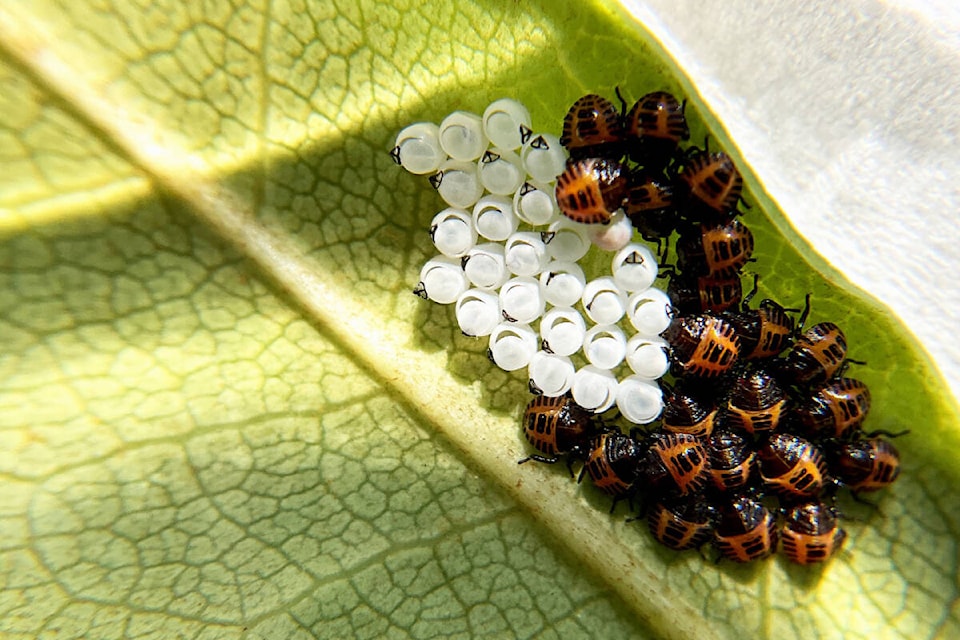Leslie Cox
Special to the Record
Pest alert!
Text by Leslie Cox; photo by Diana Scott
Well, here I am talking about pests again. A bit morbid, I admit, but as I stated in my last column, forewarned is forearmed. And when it comes to some pests, at least, the earlier you can get into control-, or hopefully, eradication-mode the better your plants, fruits and vegetables will fair.
So, what has appeared now? A fresh batch of brown marmorated stink bug (BMSB) nymphs. They were discovered on the underside of a rhododendron leaf recently by my friend, Diana. And that was another surprise. Nowhere have I seen mention of rhodos being a host plant of BMSBs…and believe me, the list of host plants is long.
Admittedly, Diana’s batch of BMSBs is not the first batch of eggs to have hatched this season. The overwintering adults will have emerged, done their mating thing and laid the first batch of eggs back in late May or early June.
With a life cycle from egg to adult that of roughly six weeks, Diana’s batch of BMSBs could conceivably have been the first brood of the season from just one of this year’s new females. I should warn her to keep looking for new hatchlings. Given that one female laid a clutch of 28 eggs, she still has another 14 clutches to produce over the season.
Are you following the math here? There could be quite an increase in the number of BMSBs appearing this season. Everyone should be on the lookout for them and actively eradicating them.
To pinpoint your search a little, BMSBs adore such crops as apples, soybeans, peppers, amaranth, sunflowers, mulberry, hazelnuts, apricots, cherries, peaches, pears, eggplant, figs, pumpkin, Swiss chard, tomatoes, grapes, blueberries, raspberries, blackberries, chokeberry, corn and more.
The list of ornamental plants is longer: viburnum spp., hemlock, linden tree, stewartia, mountain ash, sumac, oak, willow, cherry laurel, dogwood, holly, magnolia, honeysuckle, crape myrtle, Rose of Sharon, ginkgo, honey locust, butterfly bush, forsythia, purple loosestrife, comfrey, snapdragon, red horse chestnut, maple tree spp. and more.
All-in-all, there were more than 170 host plants on the brown marmorated stink bug’s preferred menu. I have just noted most of the plants that are found here in the wild or cultivated in our gardens, which will cut down your hunting range a little.
I do not recommend squishing any that you find on your plants because they are called stink bugs for good reason. Instead, keep a small bucket of soapy water handy over which you can shake the pests off your plant and into the water. A lid for your bucket is a good idea as adult BMSBs do have wings.
Jumping ahead towards mid- or late September, the BMSBs will start thinking about overwintering. And this phase is where I found another interesting fact. Contrary to previous scientific thought, a study conducted at the Entomology Department at Virginia Tech and published in the American Entomologist Journal found the timing when BMSBs head for warm, dry overwintering spots is prompted by diel patterns in light and dark phases, not by temperature.
The change in day-length hours in September prompts the BMSBs to stop feeding and start searching for dark sheltered places to spend the winter. It is also during this time when, in simplified terms, changes in certain sugars in their blood will occur to protect the insect from freezing.
Hopefully, this bit of BMSB life cycle and overwintering timing information will sharpen your investigative senses towards thwarting both a growing population this season and keeping them out of your house or garage this winter.
You might try prominently displaying something red to lure the BMSBs where you can then easily knock them into your soap bucket. Dirk discovered quite a number of BMSBs really liked the red siding on his house!
Leslie Cox co-owns Growing Concern Cottage Garden in Black Creek.



